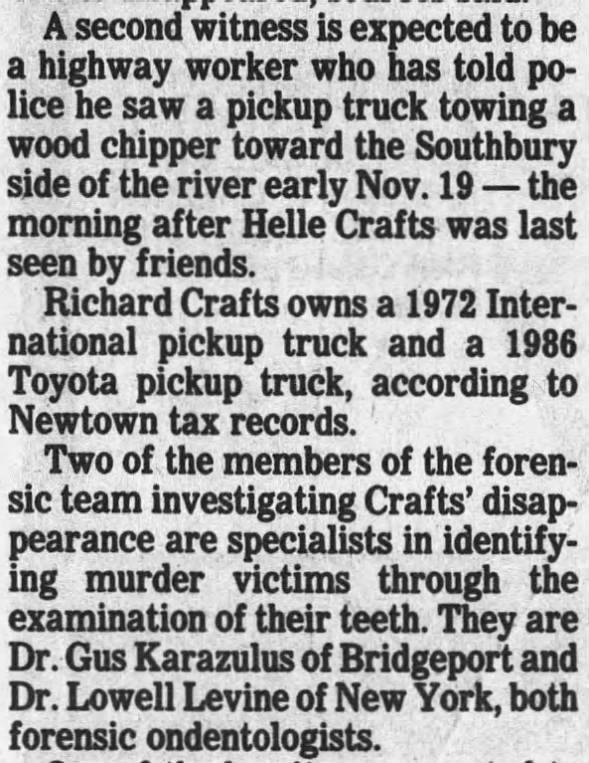Author: Shane Lambert
Helle Crafts was a flight attendant who went missing on November 8th, 1986. She was a flight attendant who was last seen by other flight attendants at about 6pm that evening.
Her case is interesting for a couple reasons: firstly, her disappearance and murder were covered in the very first episode of the series Forensic Files (originally aired on April 23rd, 1996). Secondly, the conviction of Richard Crafts, Helle's husband, was the first conviction without a body in the state of Connecticut.
The case is also interesting for those that remain skeptical of using so-called "lie detectors" to try and establish the innocence or guilt of an individual. Richard Craft was convicted of murdering Helle Crafts, however, prior to the conviction, he had passed a lie-detector test.
The more formal name of a lie-detector test is a polygraph examination. This was a subject that was covered in a course I took on Private Investigation with ICS Canada (Online Private Investigator Training Course). The course material used the following definition:
"A polygraph examination is a scientific method to aid in determining deception or truthfulness by obtaining recordings of physiological phenomena such as changes in blood pressure, pulse, and respiration (breathing)."
The recreation of the polygraph examination in the Forensic Files episode appears to be true to what I learned in the course. The only people that are meant to be in a room during a polygraph examination are the subject and the polygraph examiner.
I have watched other forensic television shows where several police officers are present during a polygraph examination. These should be scoffed at as they do not accurately depict the professional standard of a polygraph examination.
In the case of Richard Craft, he was able to beat the polygraph examination. That is, he was able to tell lies that the polygraph examiner was not able to detect. There are many possible explanations for this and they include the polygraph examiner's errored analysis of the data that he/she received. Furthermore, there are known countermeasures to a polygraph test but these may involve using drugs that would create behaviors that are easy to spot.
Machines are objective in spitting out their results but people reading the data that machines produce is another matter. Furthermore, machines need to be collaborated and this can be done wrong by the human in charge of it. If you understand that human error can cause problems with polygraph tests, then you can understand why the results should only be food for thought as opposed to something that's 100% accurate.
Clearly, forensic evidence is far more valuable than the results of polygraph examinations. In the case of Richard Crafts, forensic evidence was given more weight than his polygraph examination.
While Helle Crafts' body was never found one of her teeth was conclusively found. This tooth was scattered amidst other remains that were identified as human and of the same blood type as Helle. In the same area of these remains, a chain saw had been discarded and this item was linked to Richard Crafts through documents. Additionally, a woodchipper was seen to have been operating in the area where Helle's remains were found. Lastly, Helle's disappearance happened in the context of marital problems with Richard Crafts.
Wed, Jan 14, 1987 – 17 · Hartford Courant (Hartford, Connecticut) · Newspapers.comThe first episode of Forensic Files is definitely one that students of forensics should pay attention to. It contains several pointers that can be used as food for thought in other cases. I will make my points on the episode as noted below:
- Richard and Helle Crafts were in a crumbling marriage that included infidelity, lies, the husband not spending time at home, and a hired Private Investigator; that latter circumstance reveals crumbling trust while the other circumstances have to be considered risk factors that might precede the disappearance of a spouse.
- The forensic study of human blood is known as serology; in this episode, there is an interesting detail about serology that is discussed during Dr. Henry Lee's interview; at the 7:50 mark of the Youtube video below it's revealed that forensic medicine (the study of the human body for forensics) can reveal whether blood is from circulation blood or menstrual blood; of course, if blood in a crime-scene room is the latter then it might be held to mean that its presence is not indicative of a criminal act whereas the former increases suspicion of such; this is something that students of forensics should be aware of.
- Another pointer to take away from the episode is that filed-off serial numbers are not necessarily gone for all-time; I've seen this in other forensic shows as well where car serial-numbers can be found; there is a process to find the serial number beneath the filed-off numbers and the forensic scientists employed in Helle Crafts' case were able to identify the chainsaw's serial number despite the fact that he had been filed off.


.jpg)
.jpg)

.jpg)




No comments:
Post a Comment